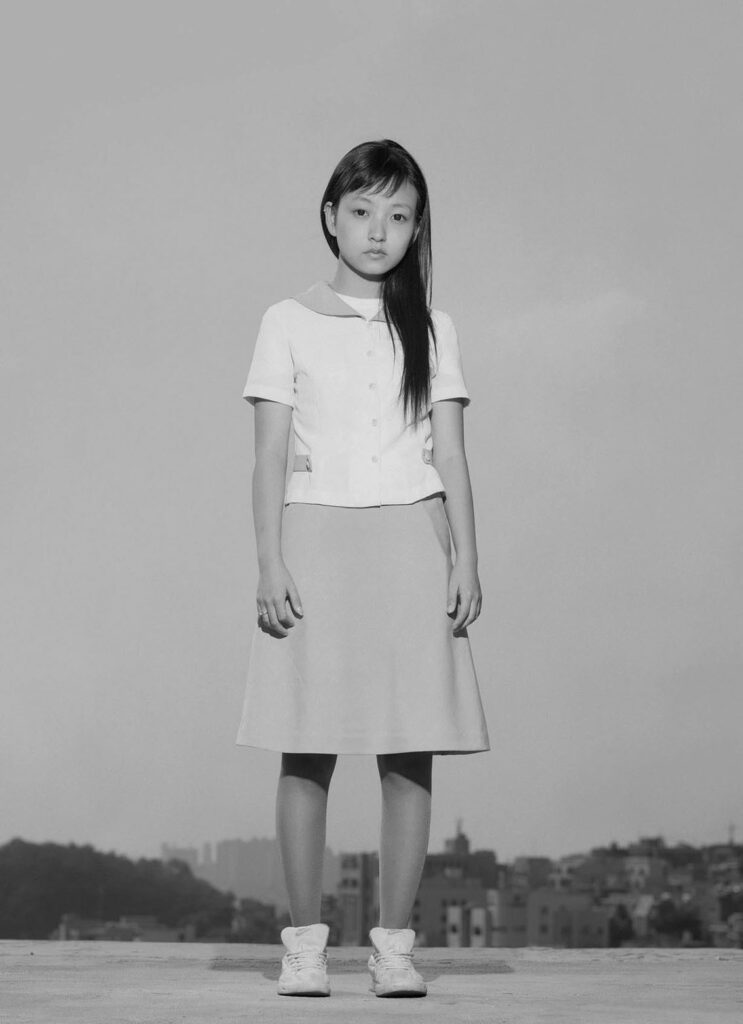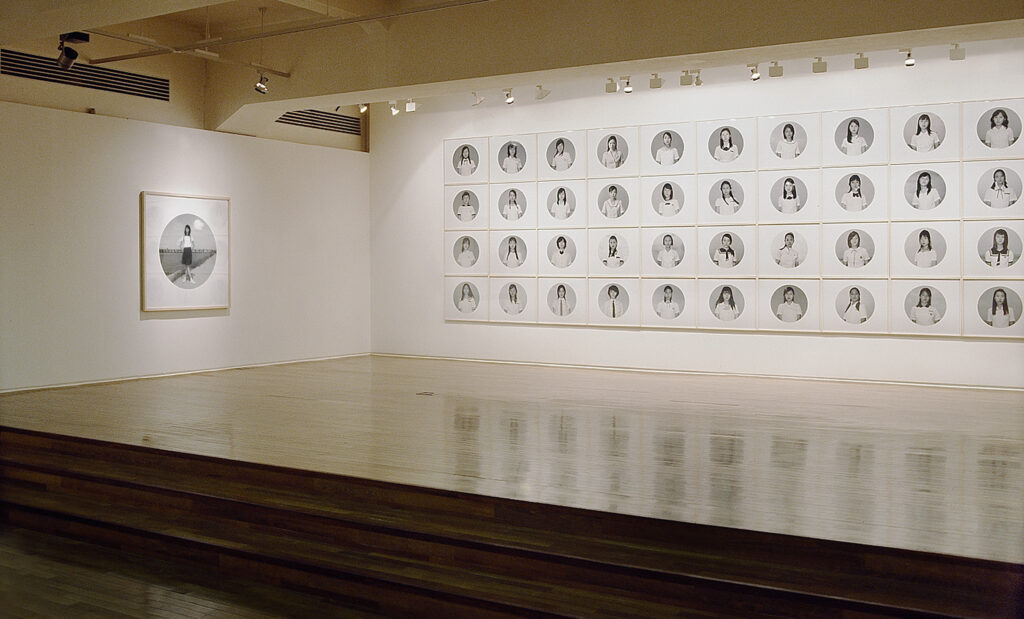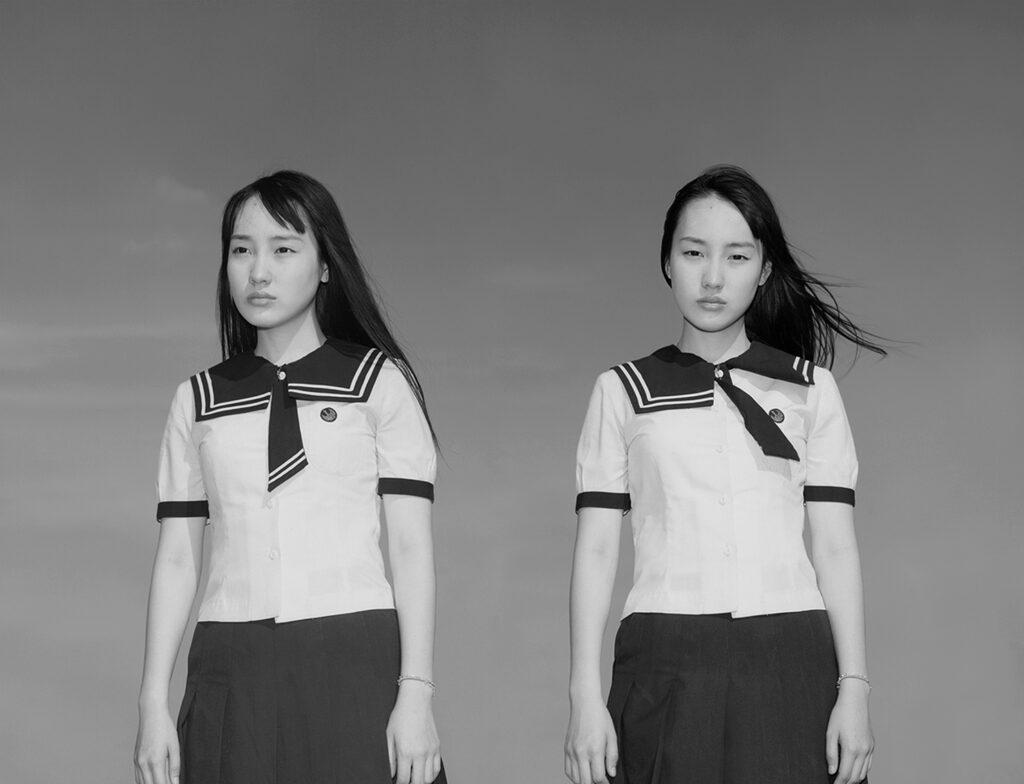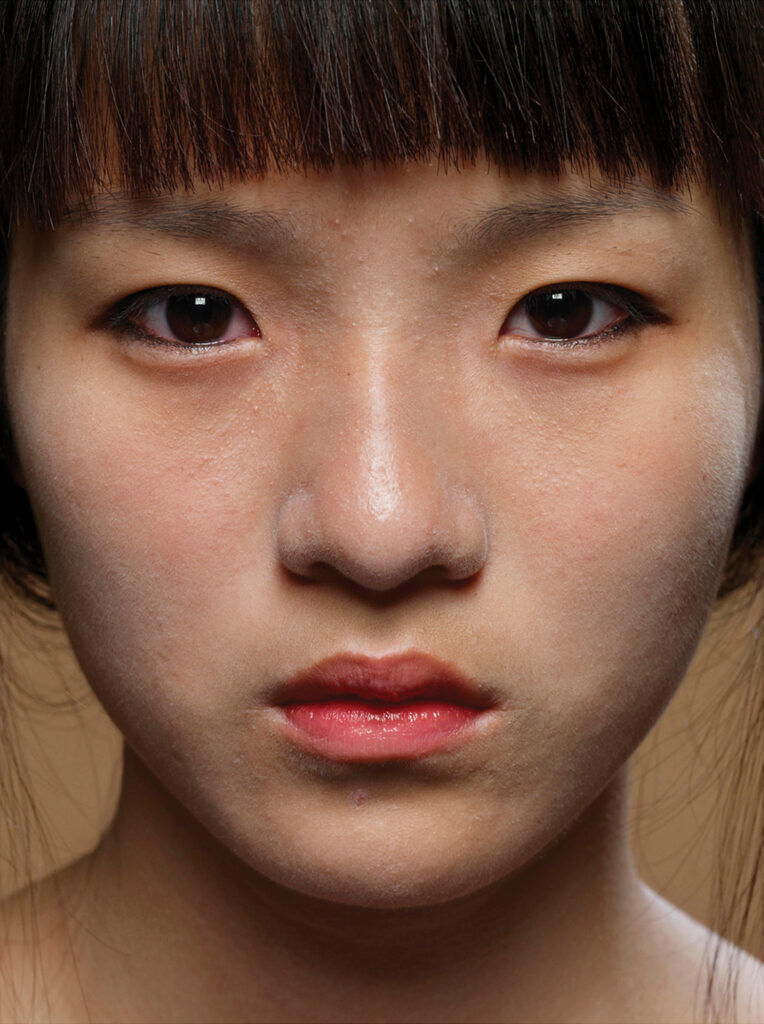From Girl’s Act to Cosmetic Girls
Hein-kuhn Oh
I began photographing portraits of girls in 2001 with the Girl’s Act series (2001-2004): portraits of high school girls studying in acting school, and subsequently, Cosmetic Girls (2005-2009): portraits of girls wearing make-up that I met on the street. Initially, I was interested in the psychological order between ‘childhood and womanhood’ but later I was more intrigued the duality in our society of the ‘subject and object of desire’. In discussing Cosmetic Girls, I want to first mention the background and working process of my earlier series, Girl’s Act.
Girls and Women
 Am.biv.a.lent
Am.biv.a.lent
- adj.
1. unstable
2. of double values; feeling both love and hatred
an _feeling toward religion; Conflicting feelings toward religion
3. coexisting, of having relations with either gender
- n. Person who is sexually attracted to both men and women
The photographic critic Ann Beattie uses the term ‘ambivalent’ to describe ‘child-like and womanly’ heterosexual characteristics of girls. With a similar idea in mind, I began to photograph high school girls in the summer of 2001. However, as the work progressed, I realized that their ambivalence had more to do with an increasingly delicate distinction between ‘girls and women’ rather than between ‘children and women,’ as a result, I came to focus on revealing the crossroads of their girlish gaze and symptoms of womanly developments surfaced through the postures of their hands, bodies. In this way, I wanted to capture the emotional instability of high school girls who were still in an unstable moment of their lives.
Girl’s Act
In the beginning, I had planned to photograph ordinary high school girls that I encountered in the streets. However, issues related to Rights of Publicity hindered the progress of my work. Then about half-way into this project, there was a great leap forward when MTM, an actor’s academy, was able to facilitate and introduce me to high school girls who wanted to become actresses. Although these girls in particular could be collectively categorized into a group of actor’s academy students, their lack of experience in acting and their age and status as ‘high school students’ made them suitable for realizing my project. Then around the summer of 2002 when I was intensely involved in the project, I began to notice an overall girlish gesture that was beyond the initial frame or idea of ‘high school girls’. These so-called girlish gestures sometimes resembled the hazy and sorrowful expression of the TTL girl, Eun-kyung Im[1], or the sensual and mature expression of Young-ae Lee[2] in the commercial called ‘Drama’. (Personally, I call it the ‘questioning look’; an expression that seems to say ‘The world? I don’t know what kind of a place it is’) What I found most fascinating is that the girls seemed to know exactly what kind of expressions they should make like they were following a set of instructions so that they could become a part of the mainstream entertainment. Furthermore, though it may seem like the girls made this formula themselves, it is more likely that they actually acquired this look through television or films. Although it is my assumption, the girls might have practiced the questioning look of Eun-kyung Im or Young-ae Lee, hundreds of times in front of the mirror or in photo booths with their friends.
Then, I wondered what makes these girls adopt such looks. Maybe it is both the entertainment media and our desire to have them appear innocent and naive. From this point, the focus of my project shifted from ‘high school girls’ to ‘girls who act as girls’ and the title of the work thus became Girl’s Act.
About the School Uniform and the Voyeuristic Gaze
It is well known that school uniform elicits a strongly voyeuristic gaze. For some time now, it has been considered as a sexual code applied to girls, whether it is related to the vulgar gaze of middle-aged man or the general sexual fantasy about it, I think it is fair to say that this voyeuristic gaze is a part of my project; for that reason, highly sensual oval shapes were chosen for framing full-length body portraits of the girls, and voyeuristic circles for face portraits.
Encyclopedic Book and Graduation Album
Generally, a typological approach can be seen as a mode of categorizing individual characters but also it negates the individual’s aura and makes them anonymous. Graduation albums and encyclopedic books are similar in this regard. For example, if you look at each photo, there is a sense of individuality as he or she belongs to one specific group – such as Year 2, Room 3 – but if each photo is seen collectively with others, it merely represents a graduation album of some school. The individual disappears in their associated group. That is to say, a photographic portrait can mark the expression of individuality, but anonymity could occur with its abstractness in repeating the group portraits in an identical format such as a graduation album. Therefore, capturing the aura of the large group of high school girls rather than that of each individuals dressed in uniforms became more important in this project. An old graduation album given by a painter inspired me to shape this project as an important inspiration and source material.

Middle-Grey Tonal Rendition (Grey Tone)
When one considers photography as a record or information, I think that gray tone conveys documentative objectivity, but also, from a sensual perspective, it could reflect the subtle sensitivities because of its vulnerability in colour. When I began the ‘high school girls’ project, I first thought that the photographs should show the full gray tone in its technical terms. However, as I previously mentioned, this work relates to the individuals who stand at the ambiguous crossroad between ‘child-like and womanly,’ thus, rather than a distinct contrast between black and white, I thought the gradation of grey tone was suitable in portraying the delicate uneasiness and anxiety of high school girls. In this way, I thought this girl project could differ from my previous projects such as Ajumma[3] or Itaewon Story[4], as a way in which the subjects in this project were not lit brightly or separated from the dark background. I felt no need to isolate or segregate their every day and the anxious psychology. I wanted these portraits to permeate into their ordinary everyday.
About the sequential format of repetition
The most interesting aspect of this Girl’s Act project was observing the changes in their underdeveloped delicate sentiments, transitioning from a girl to a woman with each single moment. I repeated the act of photo taking because I was intrigued by this uncertain identity. However, as revealed in the typological approach (of pictorial books and graduation albums), identical format or repetition of images create a loss of individual aura captured in the photographs. Therefore, it is my deliberate intent to show the subtle emotive differences between a girl and a woman portrayed through their expressions as sequential stills rather than through repetition. It is my wish to show the tenuous images of their subtle desires in the form of sequential stills vividly.

Sonyeo Sidae and Cosmetic Girls, 2005
“Girls are both the subject and the object of desire.”
Like the interesting observation of girls of art critic Jee-Suk, Beck quoted above, I was drawn to the duality of girls’ roles as “subject and object of desire” in contemporary Korean society. For instance, since 2004, numerous middle aged male fans known as samchon (Korean for ‘uncle’) and obba(Korean for ‘elder brother’) are enchanted by a variety of sexy girl groups that have gained popularity – Sonyeo Sidae[5] (literally meaning ‘girl’s era’ in Korean, also called Girl’s Generation in English), Wonder Girls, kara,[6] etc. – and as a result, the marketing strategies of an entire entertainment and culture industry that includes music, film, and fashion is highly geared towards this girly taste. It is worth grasping that a lot of viewers still call my exhibition Sonyeo Sidae instead of Sonyeo Yeongi (Korean for ‘girl’s act’). In actuality, it does not matter that much considering the members of the girl group are experts in the practice of girl’s act. In addition, a lot of sensitive girls in this era learn girliness from them – mostly regarding their appearance such as clothes, make-up, and hair styles, but also the way they behave and talk on TV talk shows and the personality they convey – so today is in fact the girl’s act era. Since 2005, I began my girls’ project again, this time on the street with focus on their make-up.
Cosmetic Girls, 2005~2009
‘Cosmetic girls’ could be found all around downtown Seoul, in areas such as the Dongdae-mun Migliore shopping center, near Ewha Woman’s University, the so-called ‘soondae (Korean sausage) alley’ in Sinrim-dong, near Sungshin Women’s University, or Rodeo Street in Apgujeong-dong[7]. Eight female students studying photography in college – I called them my “GMS (girls’ make-up style)” casting managers – helped get more than 500 teenage girls interested in my project, out of which 138 visited my studio and were photographed for portraits. This book contains the portraits of 28 ‘significant’ cosmetic girls and their self-made make-up styles. Even though it is not mentioned in the title, ‘significant’ also refers to girls who wore make-up that was representative of a certain area and were thus important from a social report point of view, showing the different make-up and fashion styles among the different areas of the city. As a photographer dreaming of a visual drama, I hoped for the girls to be more like the Gyaru[8] girls in Japan. To my disappointment though, the make-up trend among Korean girls in 2005 was focused on natural skin tone enhanced by their fasion so-called BB cream, a kind of a tinted moisturizer. However, their make-up practice was more active than I expected, including circle lenses[9] (that make the pupils seem bigger and more distinct), colored lenses, hair dying, hair extensions, color make-up, manicures, and pedicures. In addition, there were even girls who had dared to have adult-type procedures such as Botox, Petit Surgery,[10] and plastic surgery to enlarge the eyes. (Plastic surgery is prohibited by law to adolescents under the age of 17.) I pursued the project for three years until 2009, during the time I felt like Korea was the ‘Republic of Cosmetics’.
An Encyclopedic Book of Girls; a Typology of Girls
In the beginning, I considered either An Encyclopedic Book of Girls or A Typology of Girls for the title of the Girl’s Act series. However, there was a serious widespread voice in Korea in 2004 calling to reprimand sexual promiscuity among adolescence and sexual relations with minors. As a result, the current, slightly ambiguous title of Girl’s Act was born, following the organizers’ opposition to the other titles that they found too provocative and unethical-sounding. In truth, it is just as impossible to typify girls within a typology as it becomes unethical. The definition of ‘girls’ is too subjective for typological photography, which should be detached from emotions and faithful to its objective and rational classification. The theme of make-up is also much too subjective and emotional to be dealt within typological photography. However, Cosmetic Girls was shot all the more like an encyclopedic book or a typology of different make-up look. As a result, it is expressed through a certain lighting, viewing angle, and convention ofphotographic representation. This is because I felt that Korean teenage girls, who take entertainers as their role models and for their role play, are typified and formula-ized. In portraits, typology is a highly unethical and cruel field.

Façade of Cosmetics
“Façade is a physical direction, whereas frontality is a psychological construct. While the façade deals with the relationship between a model and the camera, the frontality exists between a model and the viewer.”
Dong-seon Jin, Aesthetics of Photography, SajinYesulsa, 2001
Teenage girls’ make-up is a means to reveal the femininity that they desire to be, and yet at the same time, it is a defensive tool to hide the unstable identity. I thought that make-up resembled a kind of mask. However, in Cosmetic Girls I deal with the façade of girls’ make-up more closely. This is because, in terms of my photographic subjects, I realize that make-up functions as the façade that they want to show rather than as a mask that they try to hide. Girls, who have formed their exteriority influenced by the media entertainers, are well aware of this – what kind of frontal image they must show when they are photographed. To apply photographic critic Dong-seon, Jin’s statement above, the façade of these girls’ make-up reveals their desires close to the media’s gaze. The frontality which has something to do with the true inner self can be hardly embraced in my project. That is to say, in general, identity is about the inner self and the façade reveals this identity of an individual where her desire is almost fully expressed. Girls’ identities are not within them, but on their façade. In conclusion, the girls we can recognize are merely their façade and images.
[1] Eun-kyung Im: a young Korean actress who was also called the ‘TTL girl’. She popularized mysterious girl look among Korean teen girls through Samsung cell-phone commercial
[2] Young-ae Lee: a well-known Korean actress who portrayed beauty of a sensual and mature woman through numerous films, dramas and commercials
[3] Ajumma: a term to generally call middle-aged women in Korea. It is sometimes used as a colloquial expression to belittle or make fun of women or compare them with younger women. Hein-khun Oh made a series of photographic portrait in 1999 under the title of Ajumma, in which Oh captured various looks of middle-aged Korean women
[4] Itaewon Story: a district in Seoul with a bunch of entertainment facilities. a series of work by Hein-kuhn Oh featuring portraits of amateur singers, waiters, strip dancers, and gay hosts(1993)
[5] Sonyeo Sidae: a popular all-girl singing group who have gained huge popularity since 2005 and whose members are mostly in their teens
[6] Sonyeo Sidae, Wonder Girls, Kara: names of girl groups whose members are mostly in their teens
[7] Sinrim-dong, near Sungshin Women’s University, or Rodeo Street in Apgujeong-dong: names of popular districts where a lot of adolescents gather to hang out
[8] Gyaru: a group of Japanese girls who like to wear strong make-up
[9] Circle lenses: contact lens which makes pupils look clearer and bigger
[10] Petit Surgery: a name for minimally or non-invasive treatments which takes quite a short time
© 1989-2024 HEINKUHN OH